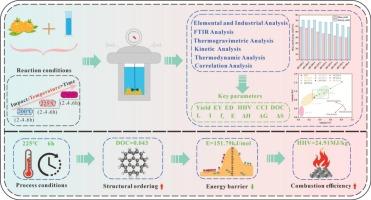Hydrothermal carbonization of waste Rosa roxburghii Tratt pomace into solid fuel: mechanisms, combustion characteristics and thermodynamic studies
IF 5.4
3区 工程技术
Q2 ENERGY & FUELS
引用次数: 0
Abstract
Rosa roxburghii Tratt (RRT) pomace, a major byproduct of juice processing, exhibits a high specific surface area and roughness, demonstrating significant potential for biomass energy production. Improper disposal may lead to environmental pollution and resource waste; thus, high-value utilization offers both economic and environmental benefits. This study employed hydrothermal carbonization (HTC) to convert RRT pomace into highly stable biomass fuel, aiming to elucidate the reaction mechanism and identify the optimal process conditions. Proximate and ultimate analyses revealed that, with increasing temperature and duration, the hydrochar yield and volatile matter content decreased, while the fixed carbon content and calorific value significantly increased, exhibiting coal-like characteristics. Structural evolution analysis revealed that deoxygenation and aromatization played dominant roles, with an increase in tetra-substituted aromatic rings and a decrease in oxygen-containing functional groups, confirming the transformation of the carbon skeleton into a highly stable bituminous coal-like structure. Under the optimal condition of 225 ℃ for 6 h, the resulting hydrochar exhibited an elevated ignition temperature of 323.14 ℃, significantly improved storage safety, a 25.24 % reduction in average activation energy, and a negative entropy change, indicating enhanced system ordering and reduced reaction energy barriers. Mechanistic studies indicated that the HTC process involved three stages: hydrolysis-dehydration, condensation-aromatization, and carbonization, with 225 ℃ identified as the threshold temperature that balances carbon enrichment and ash suppression. This study offers a theoretical foundation for high-value utilization of RRT pomace, thereby contributing to the resource recovery of agricultural waste and the development of clean energy.

水热炭化废刺梨渣为固体燃料:机理、燃烧特性及热力学研究
玫瑰果渣(RRT)是果汁加工的主要副产物,具有较高的比表面积和粗糙度,具有巨大的生物质能源生产潜力。处置不当可能造成环境污染和资源浪费;因此,高价值利用既能带来经济效益,又能带来环境效益。本研究采用水热碳化法(HTC)将RRT渣油转化为高稳定性生物质燃料,旨在阐明反应机理并确定最佳工艺条件。近似分析和终值分析表明,随着温度和持续时间的增加,烃类产率和挥发物含量降低,固定碳含量和热值显著增加,呈现煤样特征。结构演化分析表明,脱氧和芳构化起主导作用,四取代芳环增加,含氧官能团减少,证实碳骨架转变为高度稳定的烟煤状结构。在225℃反应6 h的最佳条件下,产物的着火温度提高了323.14℃,储存安全性显著提高,平均活化能降低了25.24%,熵变为负,表明体系有序性增强,反应能垒降低。机理研究表明,HTC过程包括水解-脱水、凝聚-芳构化和碳化三个阶段,并确定225℃为平衡碳富集和抑灰的阈值温度。本研究为RRT渣的高价值利用提供了理论基础,有助于农业废弃物资源化利用和清洁能源的发展。
本文章由计算机程序翻译,如有差异,请以英文原文为准。
求助全文
约1分钟内获得全文
求助全文
来源期刊

Thermal Science and Engineering Progress
Chemical Engineering-Fluid Flow and Transfer Processes
CiteScore
7.20
自引率
10.40%
发文量
327
审稿时长
41 days
期刊介绍:
Thermal Science and Engineering Progress (TSEP) publishes original, high-quality research articles that span activities ranging from fundamental scientific research and discussion of the more controversial thermodynamic theories, to developments in thermal engineering that are in many instances examples of the way scientists and engineers are addressing the challenges facing a growing population – smart cities and global warming – maximising thermodynamic efficiencies and minimising all heat losses. It is intended that these will be of current relevance and interest to industry, academia and other practitioners. It is evident that many specialised journals in thermal and, to some extent, in fluid disciplines tend to focus on topics that can be classified as fundamental in nature, or are ‘applied’ and near-market. Thermal Science and Engineering Progress will bridge the gap between these two areas, allowing authors to make an easy choice, should they or a journal editor feel that their papers are ‘out of scope’ when considering other journals. The range of topics covered by Thermal Science and Engineering Progress addresses the rapid rate of development being made in thermal transfer processes as they affect traditional fields, and important growth in the topical research areas of aerospace, thermal biological and medical systems, electronics and nano-technologies, renewable energy systems, food production (including agriculture), and the need to minimise man-made thermal impacts on climate change. Review articles on appropriate topics for TSEP are encouraged, although until TSEP is fully established, these will be limited in number. Before submitting such articles, please contact one of the Editors, or a member of the Editorial Advisory Board with an outline of your proposal and your expertise in the area of your review.
 求助内容:
求助内容: 应助结果提醒方式:
应助结果提醒方式:


